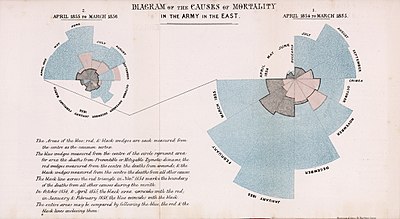121:, and not cells, are the fundamental building block of life. Béchamp claimed these microzymas are present in all things—animal, vegetable, and mineral—whether living or dead. Microzymas coalesce to form blood clots and bacteria. Depending upon the condition of the host, microzymas assume various forms. In a diseased body, the microzymas become pathological bacteria and viruses. In a healthy body, microzymas form healthy cells. When a plant or animal dies, the microzymas live on. His ideas did not gain acceptance.
31:
186:
The blue wedges measured from the centre of the circle represent area for area the deaths from
Preventible or Mitigable Zymotic diseases; the red wedges measured from the centre the deaths from wounds, & the black wedges measured from the centre the deaths from all other
136:
which means "to ferment". It was in
British official use from 1839. This term was used extensively in the English Bills of Mortality as a cause of death from 1842. In 1877,
238:
291:
105:, the term included the diseases which were "epidemic, endemic and contagious," and were regarded as owing their origin to the presence of a
336:
264:
137:
109:
principle in the system, acting in a manner analogous to, although not identical with, the process of fermentation.
283:
Children and
Industry: Child Health and Welfare in the North-west Textile Towns During the Nineteenth Century
102:
179:
168:
142:
44:
232:
114:
287:
260:
281:
254:
147:
159:
129:
76:
106:
30:
330:
227:
60:
52:
164:
98:
314:
206:
35:
Diagram of the causes of mortality in the army in the East, F. Nightingale, 1858
80:
68:
163:) towards the spread of infectious diseases. However, by the early 1900s,
56:
153:
Robert
Newstead (1859–1947) used this term in a 1908 publication in the
231:
72:
64:
17:
256:
Can bacteria cause cancer?: alternative medicine confronts big science
93:
was the name of the organism presumed to be the cause of the disease.
48:
29:
176:
Diagram of the causes of mortality in the army in the East
47:, especially "chief fevers and contagious diseases (e.g.
211:(2nd ed.). London: Longmans, Green, and Co.
157:, to describe the contribution of house flies (
8:
319:. Munn & Company. 1877-07-07. p. 5.
242:(11th ed.). Cambridge University Press.
222:
220:
218:
155:Annals of Tropical Medicine and Parasitology
286:. Manchester University Press. p. 67.
43:was a 19th-century medical term for acute
27:Medical term for acute infectious diseases
280:Marjorie Cruickshank (1 January 1981).
197:
117:proposed that tiny organisms he termed
316:Scientific American, "Zymotic Disease"
150:as the origin of infectious diseases.
103:British Registrar-General's department
146:article "Zymotic Disease" describing
7:
171:", and so the term became obsolete.
25:
208:Hospitalism and Zymotic Disease
1:
259:. NYU Press. pp. 76–77.
353:
113:In the late 19th century,
97:As originally employed by
337:Obsolete medical theories
233:"Zymotic Diseases"
253:Hess, David J. (1997).
239:Encyclopædia Britannica
205:Kennedy, Evor (1869).
189:
111:
37:
184:
95:
33:
180:Florence Nightingale
169:fermentation theory
167:"displaced the old
143:Scientific American
45:infectious diseases
38:
293:978-0-7190-0809-2
16:(Redirected from
344:
321:
320:
311:
305:
304:
302:
300:
277:
271:
270:
250:
244:
243:
235:
224:
213:
212:
202:
21:
352:
351:
347:
346:
345:
343:
342:
341:
327:
326:
325:
324:
313:
312:
308:
298:
296:
294:
279:
278:
274:
267:
252:
251:
247:
226:
225:
216:
204:
203:
199:
194:
160:Musca domestica
128:comes from the
115:Antoine Béchamp
41:Zymotic disease
36:
28:
23:
22:
15:
12:
11:
5:
350:
348:
340:
339:
329:
328:
323:
322:
306:
292:
272:
265:
245:
230:, ed. (1911).
228:Chisholm, Hugh
214:
196:
195:
193:
190:
77:whooping-cough
53:typhoid fevers
34:
26:
24:
14:
13:
10:
9:
6:
4:
3:
2:
349:
338:
335:
334:
332:
318:
317:
310:
307:
295:
289:
285:
284:
276:
273:
268:
266:0-8147-3561-4
262:
258:
257:
249:
246:
241:
240:
234:
229:
223:
221:
219:
215:
210:
209:
201:
198:
191:
188:
183:
181:
177:
172:
170:
166:
162:
161:
156:
151:
149:
145:
144:
139:
138:Thomas Watson
135:
131:
127:
122:
120:
116:
110:
108:
104:
100:
94:
92:
88:
84:
82:
78:
74:
70:
66:
62:
61:scarlet fever
58:
54:
50:
46:
42:
32:
19:
315:
309:
297:. Retrieved
282:
275:
255:
248:
237:
207:
200:
185:
175:
173:
165:bacteriology
158:
154:
152:
141:
133:
132:word ζυμοῦν
125:
123:
118:
112:
99:William Farr
96:
90:
86:
85:
40:
39:
140:wrote in a
192:References
119:microzymas
83:, etc.)".
81:diphtheria
69:erysipelas
148:contagion
124:The word
101:, of the
91:microzyme
331:Category
182:depicts
107:morbific
57:smallpox
299:23 June
187:causes.
174:In her
126:zymotic
73:cholera
65:measles
18:Zymotic
290:
263:
134:zumoûn
49:typhus
130:Greek
301:2013
288:ISBN
261:ISBN
87:Zyme
51:and
89:or
333::
236:.
217:^
178:,
79:,
75:,
71:,
67:,
63:,
59:,
55:,
303:.
269:.
20:)
Text is available under the Creative Commons Attribution-ShareAlike License. Additional terms may apply.
